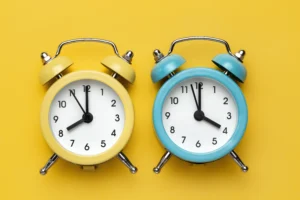In 2025, traders no longer follow the same schedules. With global markets, flexible platforms, and round-the-clock asset classes like crypto and forex, trading is no longer bound to traditional hours. But one question remains timeless: is a morning vs evening trading routine more effective?
This debate matters. Your chosen routine impacts how you plan, think, and execute trades. It affects the quality of your decisions, the clarity of your strategy, and ultimately, your profitability. The best trading routine for 2025 isn’t about what others do. It’s about what works for your lifestyle, your energy, and your edge in the market.
So let’s compare both routines in depth, from psychology and preparation to performance patterns, and help you discover your own optimal trading time for profits.
Why Morning Trading Still Wins for Many in 2025
Morning routines have a legacy. They’re structured around market opens. Stock traders follow the NYSE open at 9:30 AM EST. Forex traders watch the London open at 8 AM GMT. This time is when volume surges, price reacts sharply to overnight news, and liquidity floods the market.
A typical morning trading routine begins well before the bell. Many traders wake up two hours early. They check overnight price action, global news, and pre-market movers and finalise key levels from the day before. They enter the market with clear objectives, not guesses.
What makes mornings powerful is momentum. Price often breaks out of overnight ranges. Patterns like flags, triangles, or opening range breakouts tend to form during this phase. Traders who love short-term action, like scalping or 5-minute setups, thrive in these hours.
But it’s not just about speed. Morning routines foster discipline. When the mind is fresh and focused, decisions are sharper. Risk feels manageable. The session feels like a structured sprint, not a stressful marathon.
Consider Rina, a full-time trader in Singapore. She trades forex during the London open, which aligns with her early afternoon. Her morning routine includes reviewing news headlines, analysing GBP and EUR pairs, and noting any upcoming data releases. She takes only one or two trades per day, but her preparation allows her to act confidently within the first hour.
That’s the essence of a successful morning trader. Speed isn’t random. It’s the result of strong daily trading preparation.
Evening Trading Routines Offer Clarity and Control
As much as mornings offer action, evening trading routines offer balance. These routines are not just for working professionals. In fact, many full-time traders now prefer evenings for review, deeper analysis, and planned setups.
The evening is quieter. Markets, especially stocks, are closed. Forex continues, but with less volatility. This is the time when distractions are lower. You’re no longer reacting to price. You’re observing. You’re learning.
Evening routines usually include reviewing trades from earlier in the day, assessing emotional decisions, identifying errors, updating your journal, and studying charts for upcoming setups. Many traders spend this time scanning higher timeframes like the 4-hour or daily chart, looking for clean swing entries or preparing for the next session.
For example, Nathan, a swing trader in Dubai, prefers the calm of 9 PM. He trades crypto and gold, analysing price on the 1-hour and daily timeframes. During the evening, he checks the broader market structure, identifies support-resistance zones, and plans his entries for the next 24 to 48 hours. He doesn’t place a trade every day, but his results remain consistent because he’s not rushed.
That’s the key strength of an evening routine. It allows for patient, high-quality setups. You’re not pressured by ticking candles or sudden volatility. Instead, you’re aligning with trends, not chasing them.
Comparing Morning vs Evening Trading Strategy
The difference between a morning vs evening trading routine isn’t just about time. It’s about strategy, tempo, and temperament. Morning trading typically supports short-term execution. You’re focused on momentum, breakouts, news-based moves, and order flow. Traders often use indicators like VWAP, volume, and level 2 data. Timeframes are short, from 1-minute to 15-minute charts.
Evening trading aligns more with reflection and swing strategies. You’re analysing broader market context. Indicators like moving averages, RSI divergence, or Fibonacci retracements become more relevant. Entry decisions are slower and often placed using limit orders or alerts.
Both styles require the same level of seriousness. Just because evening trading feels calmer doesn’t mean it’s less effective. In fact, many traders lose money in the morning by trading too aggressively without preparation.
Let’s take another case. A trader named Lucas based in Canada has tried both routines. In the mornings, he used to scalp Nasdaq stocks but felt rushed and emotionally drained. After switching to an evening routine, he now trades commodities using the 4-hour chart. He feels more in control, makes fewer decisions, and earns more with less stress.
That’s what the morning vs evening trading strategy discussion is all about. Finding the flow that aligns with your thinking, not just the market clock.
The Best Trading Routine of 2025 Is the One You Can Repeat
In 2025, markets are faster, more algorithm-driven, and less forgiving to randomness. That’s why your trading routine, morning or evening, must be repeatable. It must have structure. It must be based on when you perform best, not just when the market moves.
Morning routines work best if your mind is alert early, if you can react under pressure, and if you like fast setups. These routines suit traders who have free mornings or prefer to finish trading early.
Evening routines suit traders who are analytical, methodical, and don’t mind waiting for ideal setups. They work best if you trade part-time or want to avoid trading during emotionally reactive hours.
The best trading routine 2025 doesn’t follow a trend. It fits your personality. The only universal truth is consistency. Whether you trade at 9 AM or 9 PM, you must show up daily, stick to your process, and learn from every session.
Why Daily Trading Preparation Matters in Every Routine
No routine works without proper preparation. Traders who fail often blame the market or their strategy. But the real reason is usually poor planning.
Your daily trading preparation needs to be detailed. Whether you trade in the morning or the evening, you must know the market landscape before taking a single trade.
This means checking the economic calendar, knowing the time of earnings or data releases, identifying key support and resistance levels, and understanding broader market sentiment. If you’re a morning trader, preparation starts early, ideally 90 minutes before your session. If you’re an evening trader, it starts after dinner when you can focus without distraction.
Traders who skip this prep tend to chase setups, trade impulsively, and lose confidence. Meanwhile, those who consistently prepare are rarely surprised. They expect what happens next, not because they predict it, but because they plan it.
Finding Your Optimal Trading Time for Profits
One trader’s golden hour might be another’s worst. The phrase ‘optimal trading time for profits doesn’t mean you need to trade during the busiest session. It means you need to trade when you make the best decisions.
To find your ideal time, analyse your past trades. Look at your journal. When did you win the most? When were you focused? When did you rush or hesitate?
Let’s say you discover that most of your losing trades happened between 2 and 3 PM, when you felt tired or distracted. That’s a clue. Your optimal trading time for profits is not just about the market. It’s about your mind.
You might trade better at night when you’re relaxed. Or early morning before emails or work interruptions. It’s worth testing both routines for 14 days each. Track your energy, focus, and profit. The data will guide you.
Why Many Traders Fail Without a Strong Routine
Routine builds discipline. Without it, even the best strategy fails. Traders who jump into the market without structure often overtrade, miss setups, and panic during volatility. They treat trading like a game, not a business.
A strong routine does more than schedule your time. It protects your mental capital. It helps you recover from losses. It keeps you focused on the long term.
Whether you trade in the morning or the evening, your routine should include time for analysis, execution, review, and rest. It should feel like a professional workflow, not a guessing game.
And most importantly, it should be sustainable. You can’t trade at your best if your routine burns you out.
Morning vs Evening Trading Routine: What Works Best in 2025?
So what’s better, morning or evening? The truth is, both can work if you’re consistent, prepared, and aligned with your own rhythm. It’s not about volume or volatility. It’s about matching your psychology to the market environment.
Morning routines bring speed, action, and opportunities for quick gains. Evening routines bring clarity, patience, and opportunities for clean setups. Both styles reward discipline. Both punish randomness.
If you’re still unsure, test both. Spend two weeks trading mornings, journaling results, and noting your mindset. Then switch to evenings and do the same. Review the data. Your journal will tell you everything.
In the end, the best traders in 2025 aren’t those who follow trends. They’re the ones who follow themselves.
Read here to learn more about “First 15 Minutes After Major News: Best Smart Strategy That Works“.

I’m Chaitali Sethi — a seasoned financial writer and strategist specializing in Forex trading, market behavior, and trader psychology. With a deep understanding of global markets and economic trends, I simplify complex financial concepts into clear, actionable insights that empower traders at every level. Whether it’s dissecting winning strategies, breaking down market sentiment, or helping traders build the right mindset, my content bridges the gap between information and implementation.




